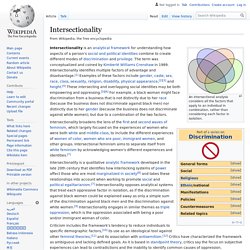

How to change your mood, just by listening to the sound of your voice. Here’s one trick to make yourself feel happier: Listen to your own voice—digitally manipulated to make it sound cheery.

That’s one potential application of a new study, in which researchers modified the speech of volunteers as they read a short story by Japanese writer Haruki Murakami. The team then altered the voice’s pitch, among other features, to make it sound happy, sad, or fearful. Intersectionality. Theoretical framework of multidimensional oppression An intersectional analysis considers all the factors that apply to an individual in combination, rather than considering each factor in isolation.

Intersectionality broadens the lens of the first and second waves of feminism, which largely focused on the experiences of women who were both white and middle-class, to include the different experiences of women of color, women who are poor, immigrant women, and other groups. Intersectional feminism aims to separate itself from white feminism by acknowledging women's different experiences and identities.[7] Criticism includes the framework's tendency to reduce individuals to specific demographic factors,[10] its use as an ideological tool against other feminist theories,[11] and its association with antisemitism.[12] Critics have characterized the framework as ambiguous and lacking defined goals.
Historical background[edit] Feminist thought[edit] Three aspects of intersectionality[edit] Asch conformity experiments. Developed in the 1950s, the methodology remains in use by many researchers to the present day.

[when?] Applications include the study of conformity effects of task importance,[5] age,[6] gender,[7][8][9][10] and culture.[5][10] Initial conformity experiment[edit] Method[edit] Psychometrics. Not to be confused with psychrometrics, the measurement of the heat and water vapor properties of air.

As a result of these focuses, psychometric research involves two major tasks: (i) the construction of instruments; and (ii) the development of procedures for measurement. Practitioners are described as psychometricians. Psychometricians usually possess a specific qualification, and most are psychologists with advanced graduate training. In addition to traditional academic institutions, many psychometricians work for the government or in human resources departments.
Jung, personas, demons, and neutral. : Megaten. Here's what a psychologist learned from interviewing killers. James Garbarino has made a living crawling into people's psyches.

Which is to say, he interviews criminals before appearing as a witness to give expert testimony in their trials. Earlier this year, the Loyola University psychologist published a book tying these experiences together, entitled Listening to Killers: Lessons Learned from My Twenty Years as a Psychological Expert Witness in Murder Cases. How cultures around the world make decisions. Sit down at a restaurant in France, and there’s a menu.

Salmon with rice. French beans. Wine. If you ask for potatoes instead of rice, the restaurant will say no. Because it is their menu. Force Yourself to Do Things By Learning How Anxiety About Tasks Works. In Pursuit Of Happiness: Why Some Pain Helps Us Feel Pleasure. The idea that we can achieve happiness by maximising pleasure and minimising pain is both intuitive and popular.

The truth is, however, very different. Pleasure alone cannot not make us happy. Small-world experiment. The "six degrees of separation" model The small-world experiment comprised several experiments conducted by Stanley Milgram and other researchers examining the average path length for social networks of people in the United States.

The research was groundbreaking in that it suggested that human society is a small-world-type network characterized by short path-lengths. The experiments are often associated with the phrase "six degrees of separation", although Milgram did not use this term himself. Milgram experiment. The experimenter (E) orders the teacher (T), the subject of the experiment, to give what the latter believes are painful electric shocks to a learner (L), who is actually an actor and confederate.

The subject believes that for each wrong answer, the learner was receiving actual electric shocks, though in reality there were no such punishments. Being separated from the subject, the confederate set up a tape recorder integrated with the electro-shock generator, which played pre-recorded sounds for each shock level.[1] Stanford prison experiment. The Stanford prison experiment (SPE) was a study of the psychological effects of becoming a prisoner or prison guard.

The experiment was conducted at Stanford University from August 14–20, 1971, by a team of researchers led by psychology professor Philip Zimbardo.[1] It was funded by the US Office of Naval Research[2] and was of interest to both the US Navy and Marine Corps as an investigation into the causes of conflict between military guards and prisoners. Goals and methods[edit] Zimbardo and his team aimed to test the hypothesis that the inherent personality traits of prisoners and guards are the chief cause of abusive behavior in prison.
Participants were recruited and told they would participate in a two-week prison simulation. Marina Abramović. Marina Abramović (Serbian Cyrillic: Марина Абрамовић; born November 30, 1946) is a Serbian[1][2][3] and former Yugoslav artist based in New York, a performance artist who began her career in the early 1970s. Her work explores the relationship between performer and audience, the limits of the body, and the possibilities of the mind. Social psychology. Social psychologists therefore deal with the factors that lead us to behave in a given way in the presence of others, and look at the conditions under which certain behavior/actions and feelings occur. Social psychology is concerned with the way these feelings, thoughts, beliefs, intentions and goals are constructed and how such psychological factors, in turn, influence our interactions with others.
In addition to the split between psychology and sociology, there has been a somewhat less pronounced difference in emphasis between American social psychologists and European social psychologists. As a broad generalization, American researchers traditionally have focused more on the individual, whereas Europeans have paid more attention to group level phenomena (see group dynamics).[3][page needed] History[edit] Intrapersonal phenomena[edit] Attitudes[edit] Balance theory. P-O-X model[edit] For example: a Person (P) who likes an Other (O) person will be balanced by the same valence attitude on behalf of the other. Symbolically, P (+) > O and P < (+) O results in psychological balance.
This can be extended to things (X) as well, thus introducing triadic relationships. If a person P likes object X but dislikes other person O, what does P feel upon learning that O created X? Cognitive dissonance. In psychology, cognitive dissonance is the mental stress or discomfort experienced by an individual who holds two or more contradictory beliefs, ideas, or values at the same time, or is confronted by new information that conflicts with existing beliefs, ideas, or values.[1][2] Leon Festinger's theory of cognitive dissonance focuses on how humans strive for internal consistency. When inconsistency (dissonance) is experienced, individuals tend to become psychologically uncomfortable and they are motivated to attempt to reduce this dissonance, as well as actively avoiding situations and information which are likely to increase it.[1] Relationship between cognitions[edit] Individuals can adjust their attitudes or actions in various ways.
Adjustments result in one of three relationships between two cognitions or between a cognition and a behavior.[1] Cognitive dissonance. Doublethink. Origin and concepts[edit] According to the novel, doublethink is: The Last Messiah. The Paradox of Choice. Anti-pattern. Erikson's stages of psychosocial development. Positive Disintegration. Obsessive–compulsive personality disorder. This is a distinct disorder from obsessive-compulsive disorder (OCD), and the relation between the two is contentious. The Last Messiah. Acetaminophen to treat existential dread? Existential crisis. Bounded rationality. Analysis paralysis. The Paradox of Choice. Wage slavery. Cotention and Bodily Awareness 'From Within' Re: Our Relationship — An Analyst's Findings. Is it love or just a rollercoaster ride?
Misattribution of arousal. Two-factor theory of emotion. Better than Before: A Psychological Field Guide to Harnessing the Transformative Power of Habit. Bad faith (existentialism) Donald Winnicott. True self and false self. Id, ego and super-ego. Analytical psychology. Abraham maslow. Carl Jung. The 16 Jungian Personality Types. INTP personality. Personality type. Abraham Maslow. Body Language vs. Micro-Expressions. Why We Procrastinate.